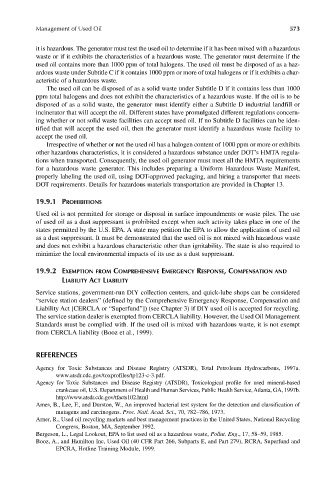Page 602 - Materials Chemistry, Second Edition
P. 602
CAT3525_C19.qxd 1/28/2005 5:05 PM Page 573
Management of Used Oil 573
it is hazardous. The generator must test the used oil to determine if it has been mixed with a hazardous
waste or if it exhibits the characteristics of a hazardous waste. The generator must determine if the
used oil contains more than 1000 ppm of total halogens. The used oil must be disposed of as a haz-
ardous waste under Subtitle C if it contains 1000 ppm or more of total halogens or if it exhibits a char-
acteristic of a hazardous waste.
The used oil can be disposed of as a solid waste under Subtitle D if it contains less than 1000
ppm total halogens and does not exhibit the characteristics of a hazardous waste. If the oil is to be
disposed of as a solid waste, the generator must identify either a Subtitle D industrial landfill or
incinerator that will accept the oil. Different states have promulgated different regulations concern-
ing whether or not solid waste facilities can accept used oil. If no Subtitle D facilities can be iden-
tified that will accept the used oil, then the generator must identify a hazardous waste facility to
accept the used oil.
Irrespective of whether or not the used oil has a halogen content of 1000 ppm or more or exhibits
other hazardous characteristics, it is considered a hazardous substance under DOT’s HMTA regula-
tions when transported. Consequently, the used oil generator must meet all the HMTA requirements
for a hazardous waste generator. This includes preparing a Uniform Hazardous Waste Manifest,
properly labeling the used oil, using DOT-approved packaging, and hiring a transporter that meets
DOT requirements. Details for hazardous materials transportation are provided in Chapter 13.
19.9.1 PROHIBITIONS
Used oil is not permitted for storage or disposal in surface impoundments or waste piles. The use
of used oil as a dust suppressant is prohibited except when such activity takes place in one of the
states permitted by the U.S. EPA. A state may petition the EPA to allow the application of used oil
as a dust suppressant. It must be demonstrated that the used oil is not mixed with hazardous waste
and does not exhibit a hazardous characteristic other than ignitability. The state is also required to
minimize the local environmental impacts of its use as a dust suppressant.
19.9.2 EXEMPTION FROM COMPREHENSIVE EMERGENCY RESPONSE, COMPENSATION AND
LIABILITY ACT LIABILITY
Service stations, government-run DIY collection centers, and quick-lube shops can be considered
“service station dealers” (defined by the Comprehensive Emergency Response, Compensation and
Liability Act [CERCLA or “Superfund”]) (see Chapter 3) if DIY used oil is accepted for recycling.
The service station dealer is exempted from CERCLA liability. However, the Used Oil Management
Standards must be complied with. If the used oil is mixed with hazardous waste, it is not exempt
from CERCLA liability (Booz et al., 1999).
REFERENCES
Agency for Toxic Substances and Disease Registry (ATSDR), Total Petroleum Hydrocarbons, 1997a.
www.atsdr.cdc.gov/toxprofiles/tp123-c-3.pdf.
Agency for Toxic Substances and Disease Registry (ATSDR), Toxicological profile for used mineral-based
crankcase oil, U.S. Department of Health and Human Services, Public Health Service,Atlanta, GA, 1997b.
http://www.atsdr.cdc.gov/tfacts102.html
Ames, B., Lee, F., and Durston, W., An improved bacterial test system for the detection and classification of
mutagens and carcinogens. Proc. Natl. Acad. Sci., 70, 782–786, 1973.
Arner, R., Used oil recycling markets and best management practices in the United States, National Recycling
Congress, Boston, MA, September 1992.
Bergeson, L., Legal Lookout, EPA to list used oil as a hazardous waste, Pollut. Eng., 17, 58–59, 1985.
Booz, A., and Hamilton Inc, Used Oil (40 CFR Part 266, Subparts E, and Part 279), RCRA, Superfund and
EPCRA, Hotline Training Module, 1999.

